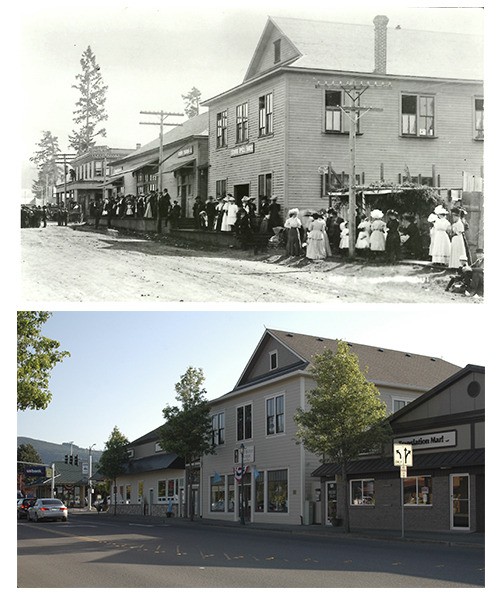With time a handful of Sequim’s landmark structures have aged, yet still stand as quiet reminders of the past. In this series Gazette staff take a step backward in time to compare these structures now from then and revisit the history, giving insight into the area’s early development.
Nestled in its original location amid the heart of downtown Sequim, The Sequim Opera House is one of few remaining reminders of the city’s development during the early 1900s.
Located near the main intersection of Washington Street and Sequim Avenue and just north today’s Hurricane Coffee Company (historically the Sequim Trading Company) with only a humble plaque and sign designating it as the Sequim Opera House, the building easily blends into the city’s modern scape.
However, at the time of its construction in 1906 by Austin Smith, contracted by Charles Franklin Seal, the Sequim Opera House was one of the largest structures in the city. The building included a retail space with an auditorium and stage above that was used for dances and high school basketball, according to “Dungeness: Lure of the River” by the Sequim Bicentennial History Book Committee.
The Sequim Opera House held its first performance, a “grand musicale” in 1907 – the same year the initial plat of the town site was filed, according to Harriet Fish, a noted Clallam County historian in the 1970s.
The premiere performance featured a “lengthy program of performances by local residents, musical societies, choral groups and an orchestra,” Fish wrote.
Fish completed and sent in a registration form for the Sequim Opera House to the Washington Department of Community Development’s office of Archaeology and Historic Preservation in February 1991. Four months later, the Sequim Opera House was approved and placed on the National Register of Historic Places.
From 1907 into the 1920s the upstairs of the Sequim Opera House was used for a variety of purposes from dances and class graduations to silent movies.
“Although it is not known when use of the Opera House was discontinued, it is believed to have been less active after 1930,” according to Fish.
Since 1980, Ed and Linda Bauer have leased the downstairs space in the historical building for their business, Bauer Interior Designs. When the Bauers moved in, half of the downstairs was devoted to a floral shop and the other an office, Linda said.
Having longtime ties to the community herself, Linda Bauer admits it’s “pretty cool” to be located in the Sequim Opera House. Although she went away for a short time to pursue school, Bauer has lived in Sequim since 1946.
“Once his (Seal’s) two granddaughters came in and gave me a copy of the Opera House’s opening night schedule,” she said.
The program includes performances by recognizable names, many of which have roads named after them, such as Lotzgesell, Seal and Cays.
Additionally, a 1913 “Grand Concert and Ball” program lists admission into the Sequim Opera House at 35 cents for adults and 25 cents for children. Dance tickets cost 50 cents and following the event the program lists supper at the Hotel Sinclair.
Although the upstairs of the Sequim Opera House is only used as storage, the scuffed stage remains to give hints of times passed.
“The interior of the Opera House retains some of its historic character particularly on the upper level,” Fish wrote. In addition to the aging stage, the “stair hall features the original drop siding and leads to two sets of double-leaf doors which open into the interior hall.”
Inside the hall, Fish also notes in her application the state’s Department of Community Development, the original fir flooring, tongue and groove siding and 16-foot ceilings faced in tongue and groove boards are featured.
Many years have passed since the stage of the Sequim Opera House has felt the presence of a show, but 109 years later the building continues to stand as “one of the last reminders of the historic nucleus of downtown Sequim,” according to Fish.
Reach Alana Linderoth at alinderoth@sequimgazette.com.



